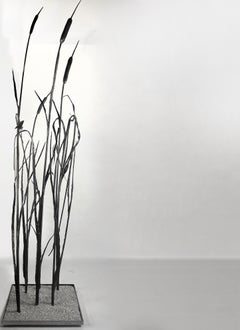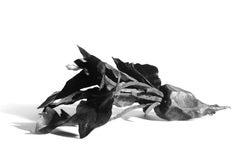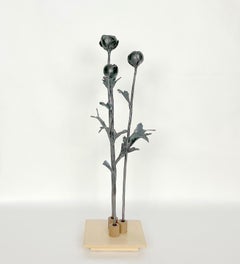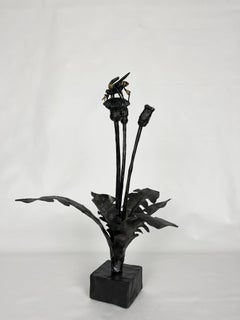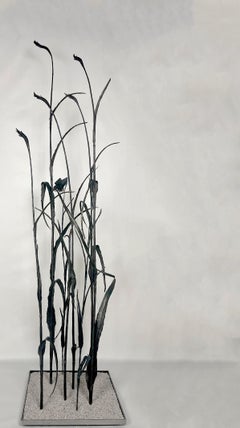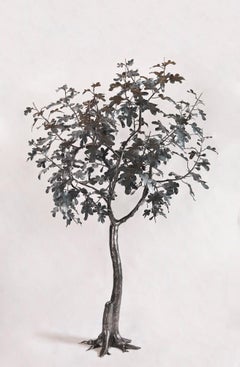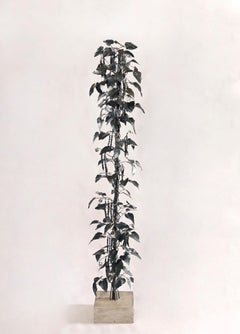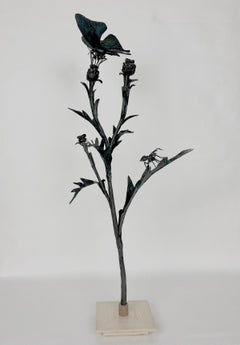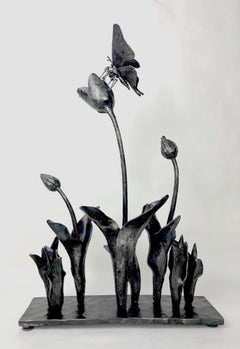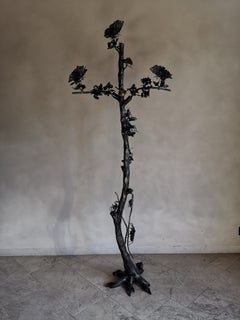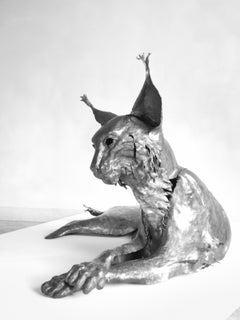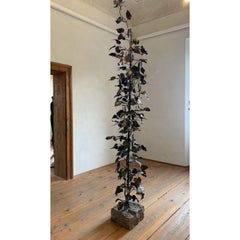Luciano Zanoni
Indoor and outdoor wrough iron sculpture - black bamboo reed bed
By Luciano Zanoni
Located in Milan, IT
Contemporary Forged Bamboo Sculpture by Luciano Zanoni
Hand-Forged Steel, Customizable Base – Italy
Category
2010s Naturalistic Figurative Sculptures
Materials
Iron
$13,246
H 46.86 in W 23.63 in D 21.66 in
Rare Beetroot sculpture in black wrough iron by fine Italian blacksmith Zanoni
By Ivan Zanoni
Located in Milan, IT
The work can be dated to 2005, when Luciano Zanoni (Ivan's father) was at the height of strength
Category
2010s Naturalistic Figurative Sculptures
Materials
Iron
$8,188
H 9.45 in W 26.38 in D 10.63 in
Jumping horse, black wrought iron animal sculpture by Italian blacksmith Zanoni
By Ivan Zanoni
Located in Milan, IT
exceptional skill was inherited from his father, Luciano Zanoni, a celebrated blacksmith and sculptor in his
Category
2010s Naturalistic Figurative Sculptures
Materials
Iron
$10,235
H 23.63 in W 9.85 in D 4.73 in
Buttercups hand-forged in iron
By Ivan Zanoni
Located in Milan, IT
The strength that springs from the ground has been miniralised by Ivan Zanoni's sculptures.
Three
Category
21st Century and Contemporary Naturalistic Figurative Sculptures
Materials
Iron
Dandelion and bee - Wrought iron and pure gold leaf
By Ivan Zanoni
Located in Milan, IT
his passion and skill from his father, Luciano Zanoni. A revered artisan, Zanoni notably created a
Category
21st Century and Contemporary Naturalistic Figurative Sculptures
Materials
Iron
$3,853
H 33.47 in W 16.93 in D 5.52 in
Incredible iron hand forged reed Perfect outdoor and indoor sculpture
By Ivan Zanoni
Located in Milan, IT
exceptional skill was inherited from his father, Luciano Zanoni, a celebrated blacksmith and sculptor in his
Category
21st Century and Contemporary Naturalistic Figurative Sculptures
Materials
Iron
$11,439
H 46.86 in W 23.63 in D 21.66 in
Black unique wrought Iron Fig Tree - majestic outdoor indoor sculpture
By Ivan Zanoni
Located in Milan, IT
Monumental Wrought Iron Tree Sculpture – A Collaborative Masterwork by Ivan and Luciano Zanoni
Category
2010s Naturalistic Figurative Sculptures
Materials
Iron
$91,518
H 110.24 in W 66.93 in D 74.81 in
Unique piece black wrought iron Beanstalk - outdoor indoor sculpture
By Ivan Zanoni
Located in Milan, IT
father, Luciano Zanoni. A revered artisan, Zanoni notably created a monumental four-meter olive tree
Category
2010s Naturalistic Figurative Sculptures
Materials
Iron
$19,869
H 86.62 in W 23.63 in D 23.23 in
Thistle with butterfly and an ant - Wrought iron sculpture
By Ivan Zanoni
Located in Milan, IT
his father, Luciano Zanoni, a blacksmith who was internationally appreciated for his art. His
Category
21st Century and Contemporary Naturalistic Figurative Sculptures
Materials
Iron
$4,094
H 24.81 in W 11.82 in D 8.27 in
Tulips and Butterfly - Unique wrought iron sculpture
By Ivan Zanoni
Located in Milan, IT
first rudiments from his father Luciano Zanoni, who elevated the blacksmith's trade to that of
Category
21st Century and Contemporary Naturalistic Figurative Sculptures
Materials
Iron
$5,418
H 22.05 in W 14.18 in D 5.52 in
Grave stone naturalistic cross wrought iron outdoor sculpture, gold bee
By Ivan Zanoni
Located in Milan, IT
inherited his passion and skill from his father, Luciano Zanoni. A revered craftsman, Zanoni created a four
Category
2010s Naturalistic Figurative Sculptures
Materials
Iron
$19,869
H 76.78 in W 39.38 in D 11.82 in
Lynx inside and outdoor sculpture unique black wrough iron feline cat natural
By Ivan Zanoni
Located in Milan, IT
.
Both Ivan and Luciano Zanoni are represented by the Milan based Salamon Fine Art gallery.
Category
2010s Realist Figurative Sculptures
Materials
Iron
$20,471
H 25.2 in W 42.13 in D 29.53 in
Lily and praying mantis hand-forged in wrought iron
By Ivan Zanoni
Located in Milan, IT
inherited the craftsmanship from his father Luciano Zanoni, an extraordinary blacksmith who was able to
Category
21st Century and Contemporary Naturalistic Figurative Sculptures
Materials
Iron
$5,418
H 33.86 in W 7.88 in D 7.88 in
Sunflower - Wrought iron indoor and outdoor sculpture
By Ivan Zanoni
Located in Milan, IT
from his father, Luciano Zanoni, who famously forged a monumental four-meter olive tree sculpture for
Category
2010s Naturalistic Figurative Sculptures
Materials
Iron
$13,005
H 88.59 in W 21.26 in D 11.82 in
Black unique iron wrought Magnolia tree - monumental outdoor indoor sculpture
By Ivan Zanoni
Located in Milan, IT
blacksmithing passed down from his father, Luciano Zanoni, who famously forged a monumental four-meter olive
Category
2010s Realist Figurative Sculptures
Materials
Iron
$87,303
H 121.66 in W 55.52 in D 55.12 in
Recent Sales
Bean Tree, Wrought Iron Sculpture by Luciano Zanoni
By Luciano Zanoni
Located in Milan, IT
Luciano Zanoni, a blacksmith by profession since his adolescence, was born in Caldes on May 20, 1943. The
Category
20th Century Still-life Sculptures
Materials
Iron
Grape tree, outdoor wrought iron sculpture unique contemporary artwork by Zanoni
By Luciano Zanoni
Located in Milan, IT
The wrought iron unique piece has been made by the contemporary Italian artist Luciano Zanoni. The
Category
2010s Realist Still-life Sculptures
Materials
Iron
Luciano ZanoniGrape tree, outdoor wrought iron sculpture unique contemporary artwork by Zanoni, 2018
H 88.98 in W 31.5 in D 30.32 in
Unique wrought iron sculpture - wine grape tree natural size - made in Italy
By Luciano Zanoni
Located in Milan, IT
The wrought iron unique piece has been made by the contemporary Italian Maestro Luciano Zanoni
Category
2010s Realist Still-life Sculptures
Materials
Iron
H 88.98 in W 31.5 in D 30.32 in
Wheat stalks, poppies, insects Sculpture - Field Flowers forged in wrought iron
By Ivan Zanoni
Located in Milan, IT
sculpture’s meticulous details. The artist, who trained in his father Luciano Zanoni’s workshop, began his
Category
21st Century and Contemporary Naturalistic Figurative Sculptures
Materials
Iron
H 33.47 in W 16.93 in D 5.52 in
Unique wrought Iron two branches Olive tree - outdoor indoor sculpture
By Ivan Zanoni
Located in Milan, IT
.
Ivan Zanoni learned about this rare activity from his father, Luciano, who, among other works of art
Category
2010s Naturalistic Figurative Sculptures
Materials
Iron
H 70.87 in W 66.93 in D 39.38 in
Olive Tree
By Ivan Zanoni
Located in Milan, IT
Luciano Zanoni flourished as an artist, from his blacksmith career when the Italian famous critic
Category
2010s Naturalistic Still-life Sculptures
Materials
Iron
People Also Browsed
Pair of Park Night Stands in Oak by Yaniv Chen for Lemon
By Lemon
Located in Amsterdam, NL
Structure:
Made from Oak veneer with solid oak edging, the Park Nightstand is finished with matching veneer on both the exterior and interior. The inside includes an adjustable shelf...
Category
2010s South African Minimalist Night Stands
Materials
Wood
$4,238 Sale Price / set
20% Off
H 24.01 in W 18.12 in D 14.18 in
Murano Round Green Glass and Brass Modern Wall Light and Sconces, 2020
Located in Rome, IT
Very special Murano glass wall light, stylish and elegant, their design truly unique in their kind. Beautiful coloring.
The wall light is composed of a brass stem where a system for...
Category
2010s Italian Mid-Century Modern Wall Lights and Sconces
Materials
Brass
$1,685 / item
H 13.78 in Dm 9.45 in
Ethnic Straw Armchair by +55design Brazilian Design with Indigenous Craft
By Neca Abrantes
Located in Jardim America, SP
This rotating armchair by Neca Abrantes is a striking fusion of contemporary Brazilian design and indigenous handcrafted traditions. Known for her deep passion for native craftsmansh...
Category
2010s Brazilian Swivel Chairs
Materials
Straw
$2,860 / item
H 29.93 in W 23.63 in D 23.63 in
Set of Eight Italian Dining Chairs in Oak and White Upholstery
Located in Waalwijk, NL
Set of eight dining chairs, black lacquered oak, white fabric, Italy, 1970s.
Outstanding set of eight geometric Italian dining chairs. These chairs combine a sculptural design that ...
Category
Vintage 1970s Italian Mid-Century Modern Dining Room Chairs
Materials
Fabric, Oak
$7,800 / set
H 29.14 in W 23.23 in D 20.87 in
Hoodoo Stacks, Sculptural Concrete Planters by OPIARY (H28"-52")
By Robert Remer
Located in Brooklyn, NY
Opiary is a Brooklyn-based biophilic design and production studio. We integrate nature in each of our designs, incorporating live greenery and organic shapes into bespoke furniture, ...
Category
21st Century and Contemporary Modern Abstract Sculptures
Materials
Cement
Custom Reclaimed Elm Wood Round Side Table with Round Legs
Located in Old Town Orange, CA
Bloom Home inc has over 2000 items in stock ready for immediate shipping, scroll down to view all of our items!
Size: 23”rd. X 20.5”h
Custom made for bloom home inc. these old elm ...
Category
21st Century and Contemporary Side Tables
Materials
Elm, Reclaimed Wood
Dark Flora #5, May Foxgloves, A floral arrangement of wild flowers and plants
Located in London, GB
Dark Flora #5 - May Foxgloves, 2020
Archival Pigment Print, Mounted on Aluminium, in bespoke Oak Framed, Edition 3/8
Foraged from Sussex Wealden woodland in early summer, it includes...
Category
2010s Contemporary Color Photography
Materials
Archival Pigment, Glass, Wood, Photographic Paper, Color
$3,446
H 29.53 in W 21.26 in D 1.58 in
Lotus Old Gold Set of 2 Side Table
Located in Paris, FR
Side Table Lotus Old Gold Set of 2 with aluminium
table tops in old gold finish and with iron feet in
antique brass finish.
Side Table A/ Diameter 18.50"xH21.30".
Side Table B/ Diam...
Category
21st Century and Contemporary Italian Sofa Tables
Materials
Aluminum, Iron
Solid Raw Oak Sideboard, France, 1950s
By Charles Dudouyt
Located in Kaštel Sućurac, Splitsko-dalmatinska županija
Solid Oak Sideboard, France, 1950s
In the sculptural tradition of Basque vernacular modernism
A study in sacred geometry and rural monumentality, this 1950s French sideboard draws f...
Category
Vintage 1950s French Art Deco Buffets
Materials
Oak
Mid Century Black Burl Round Dining Table
Located in Westwood, NJ
Featuring a luxurious Black Tamo ash veneer, this piece is designed to be a striking focal point in any dining space.
The black Tamo ash veneer exudes luxury, making it a perfect ad...
Category
21st Century and Contemporary Dining Room Tables
Materials
Wood
Amuneal's Brass Pantry Cabinetry
By Amuneal
Located in New York, NY
Amuneal's Brass Pantry Cabinetry, part of our metal Kitchen Collection, is designed as a feature element for any space. The three doors on the upper cabinets are fabricated with a kn...
Category
2010s American Modern Cabinets
Materials
Brass
Moooi Large Liquid Layers Marl Organic Rug in Low Pile Polyamide by Claire Vos
By Moooi
Located in Brooklyn, NY
Moooi Large Liquid Layers Marl Organic rug in Low Pile Polyamide by Claire Vos
Claire Vos started her studies in Industrial Design at Eindhoven's ""Design Academy"" in 1984. She w...
Category
21st Century and Contemporary Dutch More Carpets
Materials
Polyester
$4,224 / item
W 97.25 in L 157.49 in
Closed Dome Prismatic Pendent
By Early Electrics Design Studio
Located in Peekskill, NY
As with all Prismatic glass the reflections and quality of light that it projects make them a favorite. This is a 9 inch diameter dome prismatic. What make this one unique is the bra...
Category
21st Century and Contemporary American Industrial Chandeliers and Pendants
Materials
Glass
Sigma Dining Table with Walnut Root Top
By Albino Miranda
Located in Barcelos, PT
Sigma is a luxurious and sculptural dining table that is handmade produced in resin reinforced with fiberglass and combines bold finishes with amazing materials and textures. Its tab...
Category
2010s Portuguese Dining Room Tables
Materials
Resin, Fiberglass, Wood
Sideboard, Bleached Oak, France, 1940s
By Charles Dudouyt
Located in Kaštel Sućurac, Splitsko-dalmatinska županija
Sideboard, Bleached Oak, France, 1940s
Echoing the Vernacular Modernism of French Provincial Workshops Influenced by Art Deco
With its commanding central spindle and deeply sculpted...
Category
Vintage 1940s French Art Deco Credenzas
Materials
Brass
Champagne Afternoon - tall, colourful, hand-blown glass, outdoor sculpture
By Susan Rankin
Located in Bloomfield, ON
Like flowers in a garden, Susan Rankin’s beautiful glass columns appear to sway in the breeze. An avid gardener, Rankin has created a series of outdoor sculptures inspired by the for...
Category
2010s Contemporary Abstract Sculptures
Materials
Steel
$11,500
H 98 in W 18 in D 30 in
Get Updated with New Arrivals
Save "Luciano Zanoni", and we’ll notify you when there are new listings in this category.
More Ways To Browse
Gold Bee
The Blacksmith
Sculpture Of Horses
Butterfly Sculpture
Italian Horse Sculptures
Iron Horse
Black Horse Sculpture
Iron Tree
Hand Forged Iron Art
Stone Cross
Forged Iron Sculpture Sculpture
Pomegranate Tree
Black Cat Sculpture
Animal Legs
Italian Life Size Sculpture
Horse Jumping
Modular Sculpture
Praying Hands
